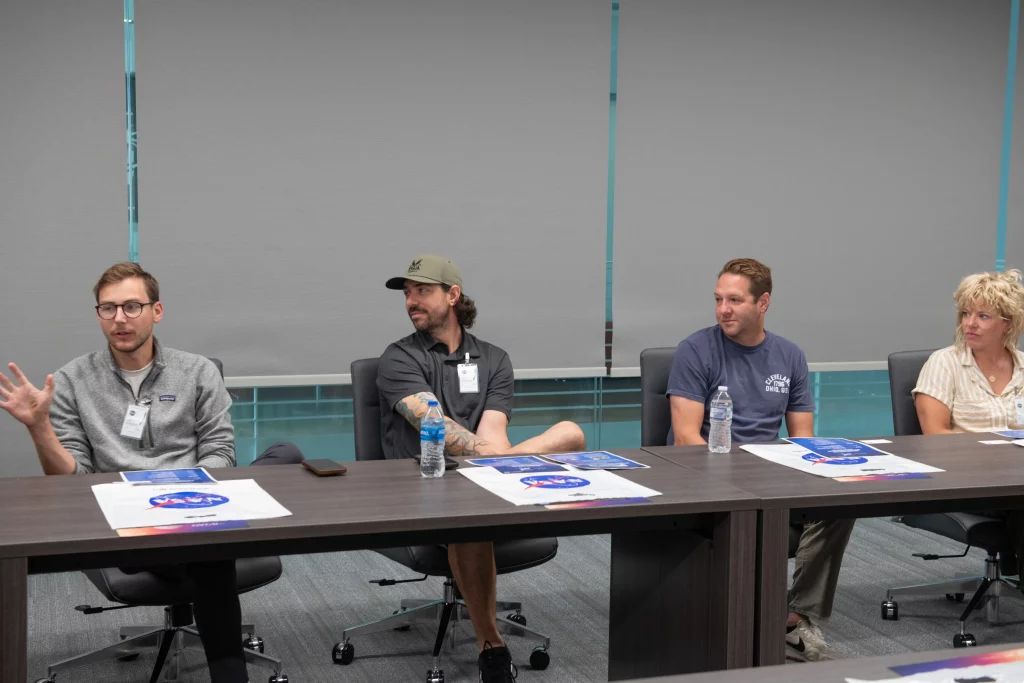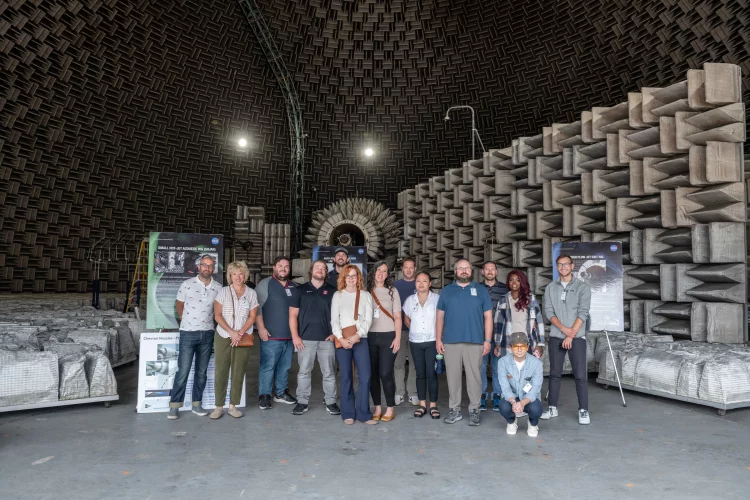Introduction
NASA’s iconic logo, known for its striking design and symbolic representation of space exploration, is more than just a visual emblem; it embodies decades of scientific achievement, innovation, and exploration. Recently, NASA Glenn Research Center in Cleveland, Ohio, opened its doors to local creators for an immersive experience centered around the agency’s emblematic logo. This event provided an opportunity to delve into the history, design principles, and significance of NASA’s logo, fostering a deeper appreciation for its role in communicating the spirit of space exploration. This article explores the significance of the NASA logo, details the recent event at NASA Glenn, and discusses the broader implications for design, branding, and community engagement.
1. The Significance of NASA’s Logo
NASA’s logo, often referred to as the “meatball” design, is a powerful symbol of the agency’s mission and achievements. Understanding its design and historical context provides valuable insights into its role as a representation of space exploration.
1.1 Design Elements and Symbolism
The NASA logo incorporates several key elements that convey its mission and values:
- The Orbital Trajectory: The red chevron or “wing” represents the trajectory of a spacecraft and signifies exploration and the pioneering spirit of space travel.
- The Stars: The stars in the background symbolize the vastness of space and the countless opportunities for discovery.
- The Blue Field: The blue field represents Earth and the agency’s commitment to global exploration and understanding.
1.2 Historical Evolution
The NASA logo has evolved over the years, reflecting changes in design trends and the agency’s growing role in space exploration:
- Early Designs: The original NASA logo, adopted in 1959, featured a more complex design with an emblematic blue circle and stars, known as the “meatball” logo.
- Modern Updates: The logo has undergone subtle modifications, including adjustments to the font and color schemes, to maintain its relevance and modernity.
1.3 Cultural Impact
The NASA logo has become an iconic symbol recognized worldwide:
- Brand Recognition: The logo is instantly recognizable and synonymous with space exploration and technological advancement.
- Public Perception: It evokes a sense of wonder and curiosity about space, inspiring both young and old to learn more about the universe.
2. The Recent Event at NASA Glenn
NASA Glenn Research Center hosted an event for local creators to explore the NASA logo’s design and history. This initiative aimed to provide insights into the logo’s significance and inspire creative thinking within the local community.
2.1 Event Objectives
The event had several key objectives:
- Educational Experience: To educate local creators about the design principles and historical context of NASA’s logo.
- Creative Inspiration: To inspire participants by showcasing how design can communicate complex ideas and values effectively.
- Community Engagement: To strengthen ties between NASA Glenn and the local creative community.
2.2 Event Highlights
The event featured a range of activities and presentations:
- Design Workshops: Interactive workshops where participants learned about the principles of logo design and branding, using NASA’s logo as a case study.
- Historical Presentations: Presentations on the history of the NASA logo, including its evolution and the stories behind its design elements.
- Creative Discussions: Discussions on the role of logos in branding and communication, exploring how visual elements can convey meaning and connect with audiences.
2.3 Participant Engagement
Participants actively engaged with the event through various activities:
- Hands-On Activities: Creative exercises allowed participants to experiment with design concepts and create their own interpretations of the NASA logo.
- Networking Opportunities: The event provided opportunities for local creators to network, share ideas, and collaborate on future projects.
3. The Broader Implications of Logo Design
The study of NASA’s logo offers valuable lessons in design, branding, and communication that extend beyond space exploration.
3.1 Design Principles and Best Practices
Key principles of effective logo design include:
- Simplicity: A simple design ensures that the logo is easily recognizable and memorable.
- Relevance: The design should be relevant to the brand’s mission and values, effectively communicating its core message.
- Versatility: A versatile logo can be adapted to various contexts and media, maintaining its impact and readability.
3.2 Branding and Identity
A well-designed logo plays a crucial role in establishing and maintaining a brand’s identity:
- Brand Recognition: A distinctive logo helps build brand recognition and loyalty among audiences.
- Communication of Values: The logo communicates the brand’s values and mission, creating a visual representation of its identity.
3.3 Community and Cultural Impact
Logos can have a significant cultural impact, influencing public perception and engagement:
- Inspiration and Aspiration: Logos can inspire and resonate with individuals, fostering a sense of connection and aspiration.
- Cultural Significance: Logos often become cultural symbols, representing broader themes and values within society.

4. The Role of NASA Glenn in Community Engagement
NASA Glenn Research Center’s initiative to involve local creators reflects its commitment to community engagement and education.
4.1 Educational Outreach
NASA Glenn’s educational outreach efforts aim to inspire and inform:
- Workshops and Events: Hosting workshops and events that provide insights into space exploration and STEM fields.
- Collaborations: Partnering with local schools, organizations, and community groups to support educational initiatives.
4.2 Support for Local Creators
Supporting local creators through events and initiatives contributes to the creative community:
- Encouraging Innovation: Providing resources and opportunities for local creators to explore new ideas and concepts.
- Fostering Creativity: Creating platforms for collaboration and creative expression, enhancing the local cultural landscape.
4.3 Strengthening Community Ties
Engaging with the community helps build strong relationships and mutual understanding:
- Community Involvement: Involving community members in NASA’s activities fosters a sense of inclusion and shared purpose.
- Public Engagement: Enhancing public understanding of NASA’s work and its impact on society.
5. Future Directions and Opportunities
The success of the recent event at NASA Glenn opens the door for future initiatives and opportunities.
5.1 Expanding Educational Programs
Future educational programs can build on the success of this event:
- Broader Outreach: Expanding outreach to include more diverse audiences and regions.
- Innovative Formats: Exploring new formats for educational events, including virtual and hybrid experiences.
5.2 Enhancing Creative Collaboration
Opportunities for creative collaboration can further engage local communities:
- Design Challenges: Organizing design challenges and competitions to encourage innovative thinking and creativity.
- Collaborative Projects: Facilitating collaborative projects between NASA and local creators to explore new ideas and concepts.
5.3 Strengthening Community Partnerships
Building stronger community partnerships can enhance NASA’s outreach efforts:
- Local Partnerships: Partnering with local organizations and businesses to support community initiatives and events.
- Public Engagement Campaigns: Developing campaigns that highlight the impact of NASA’s work and its connection to local communities.
6. Conclusion
NASA Glenn Research Center’s initiative to engage local creators in exploring NASA’s iconic logo underscores the importance of design, branding, and community engagement. By delving into the history and principles of NASA’s logo, participants gained valuable insights into effective design practices and the role of visual identity in communication. The event not only celebrated the significance of NASA’s logo but also fostered creativity, inspiration, and collaboration within the local community. As NASA continues to bridge the gap between space exploration and public engagement, it will undoubtedly inspire and connect with individuals across diverse communities, shaping the future of design, branding, and STEM education.


















































Discussion about this post